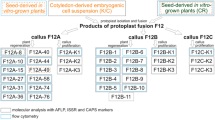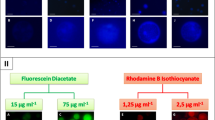Abstract
Wide hybridization that cannot be attained through conventional sexual crosses, can now be approached by somatic hybridization. Protoplasts of I. ensata and I. germanica were fused by electrofusion. For the selection of somatic hybrids, protoplasts of I. ensata which did not form colonies in protoplast culture and protoplasts of I. germanica which had regeneration ability for only albino shoot were used in symmetric fusion. On the other hand, the protoplasts of I. ensata and I. germanica protoplasts which were inactivated by iodoacetamide (IOA) treatment were used in asymmetric fusion. Five-six months after cell fusion, green plants were obtained in the symmetric and asymmetric fusion. In the random amplified polymorphic DNA (RAPD) analysis, the green plants had bands specific to both parental species. Therefore, these plants were somatic hybrids between I. ensata and I. germanica.
Similar content being viewed by others
References
Aii, J., M. Nagano, G.A. Penner, C.G. Campbell & T. Adachi, 1996. Identification of RAPD markers linked to the homostylar (Ho) gene in buckwheat. Breeding Science 48: 59–62.
Chu, C.C., C.C. Wang, C.S. Sun, C. Hsu, K.C. Yin, C.Y. Chu & F.Y. Bi, 1975. Establishment of an efficient medium for anther culture of rice through comparative experiments on the nitrogen sources. Sci Sinica 18: 659–668.
Gleba, Y.Y. & F. Hoffmann, 1979. Arabidobrassica: Plant genome engineering by protoplast fusion. Naturwissenschaften 66: 547–554.
Hida, A., K. Shimizu, R. Nagata, T. Yabuya & T. Adachi, 1998. Plant regeneration from protoplasts of Iris hollandica Hort. Euphytica (in press).
Kunitake, H., T. Nakashima, K. Mori, M. Tanaka, A. Saito & M. Mii, 1996. Production of interspecific somatic hybrid plants between Asparagus officinalis and A. macowanii through electrofusion. Plant Science 116: 213–222.
Lawrence, G.H.M. & L.F. Randolph, 1959. The classification of iris. In: Garden Irises, pp. 133–160. The Cayuga Press, New York.
Melchers, G., M.D. Sacristán & A.A. Holder, 1978. Somatic hybrid plants of potato and tomato regenerated from fused protoplasts. Carlsberg Res Commun 43: 203–218.
Motomura, T., T. Hidaka, T. Moriguchi, T. Akihama & M. Omura, 1995. Intergeneric somatic hybrids between Citrus and Atalantia or Severinia by electrofusion, and recombination of mitochondrial genomes. Breeding Science 45: 309–314.
Murashige, T.& F. Skoog, 1962. A revised medium for rapid growth and bioassays with tobacco tissue culture. Physiol Plant 15: 473–497.
Sakurai, O. & K. Tomino, 1969. Studies of Iris breeding. I. Crossing ability between Iris species involving I. ensata Thunb. var. ensata. Japan J Breed 19(Suppl. 1): 151–152 (in Japanese).
Shimizu, K., T. Yabuya & T. Adachi, 1996. Plant regeneration from protoplasts of Iris germanica L. Euphytica 89: 223–227.
Shimizu, K., H. Nagaike, T. Yabuya & T. Adachi, 1997. Plant regeneration from suspension culture of Iris germanica. Plant Cell, Tissue and Organ Culture 50: 27–31.
Tomino, K., 1963. Studies on the genus Iris in Japan especially cytotaxonomy of the genus and breeding of Iris ensata Thunberg. Bull Lib Art Dep Mie Univ 28: 1–59 (in Japanese with English summary).
Wolters, A.-M., E. Jacobsen, M. O'Connel, G. Bonnema, K.S. Ramulu, H. Jong, H. Schoenmakers, J. Wijbrandi & M. Koornneef, 1994. Somatic hybridization as a tool for tomato breeding. Euphytica 79: 265–277.
Yabuya, T. & H. Yamagata, 1980a. Pollen-tube growth, fertilization and ovule development in reciprocal crosses between Iris ensata Thunb. and I. pseudacorus L. Japan J Breed 30(Suppl. 1): 168–169.
Yabuya, T. & H. Yamagata, 1980b. Elucidation of seed failure and breeding of F1 hybrid in reciprocal crosses between Iris ensata Thunb. and I. laevigata Fisch. Japan J Breed 30: 139–150.
Yabuya, T., 1984. Fundamental studies on the interspecies-cross breeding of Iris ensata Thunb. Bull Lab Plant Breed Fac Agr Miyazaki Univ. 4: 1–111 (in Japanese with English summary).
Yamaguchi, J. & T. Shiga, 1993. Characteristics of regenerated plants via protoplast electrofusion between melon (Cucumis melo) and pumpkin (interspecific hybrid, Cucumis maxima × C. moschata). Japan J Breed. 43: 173–182.
Author information
Authors and Affiliations
Rights and permissions
About this article
Cite this article
Shimizu, K., Miyabe, Y., Nagaike, H. et al. Production of somatic hybrid plants between Iris ensata Thunb. and I. germanica. Euphytica 107, 105–113 (1999). https://doi.org/10.1023/A:1026431800693
Issue Date:
DOI: https://doi.org/10.1023/A:1026431800693




